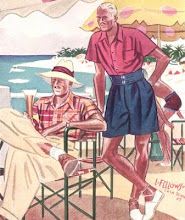
I know ive touched on this before , but here is a more rounded view of suit types.
Bespoke Confusion
The word “bespoke” is misused far more often than not. To clear up some of the confusion, herewith the types of suit-making processes explained:
A ready-to-wear (aka RTW) suit is made from a standard pattern in a standard size and customized, if at all, by the buyer's tailor.
A made-to-measure (aka MTM) suit begins with a client’s basic measurements being taken. The material chosen by the customer is cut from a bolt of cloth using a standard pattern and then altered to reflect the customer’s measurements as the garment is made. Usually there are no fittings in the making of a made-to-measure garment. The finished product is delivered to the customer ready to go and not altered unless there is a problem with the fit.
A bespoke suit begins with an entire page of measurements (35 measurements is one number given). A specialist called a “cutter” uses these measurements to draft a pattern on a piece of heavy brown paper (sometimes the tailor is also a cutter). All of the customer's physical idiosyncrasies are reflected in the pattern. The finished pattern is cut out of the brown paper and then the shell material is cut from that. The material then goes to the tailor for assembly.
After the initial visit when measurements are taken and fabrics and options are chosen the customer returns for a minimum of three fittings as the suit evolves. At the first fitting the coat is only a shell held together with large basting stitches. By the second fitting the coat will likely have some padding in it. The lining will not appear in the coat until the third fitting. At each stage the tailor makes small adjustments, marking up the material with tailor's chalk and calling out notes to a colleague. These changes are noted on the customer’s pattern and often a new pattern is cut based on what the cutter and tailor learn during the fittings.
The suit is not delivered to (I should say "released to") the customer until the tailor is satisfied with it. Russell Smith, in his book Men’s Style; The Thinking Man’s Guide to Dress, says that “a good bespoke suit is as comfortable as pajamas.” This is because it fits you as perfectly as a garment can.
It is important to note that there are excellent suits made of each of these types. So long as you are getting the suit that you are paying for you can be satisfied.



